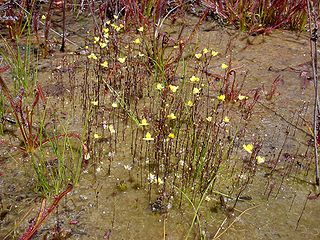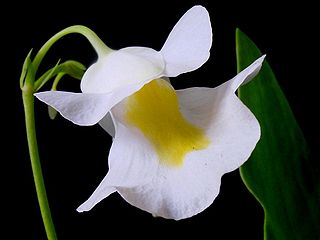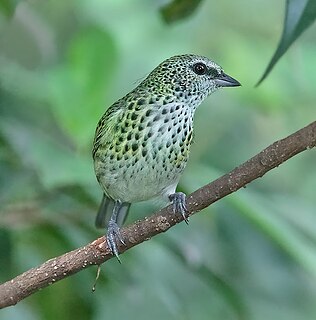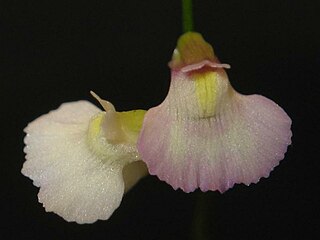
Nepenthes kampotiana is a tropical pitcher plant native to southern Cambodia, eastern Thailand, and at least southern coastal Vietnam. It has an altitudinal distribution of 0–600 m above sea level. The specific epithet kampotiana refers to the Cambodian city of Kampot, close to which the first specimens of this species were collected.

Utricularia pusilla, the tiny bladderwort, is an annual, terrestrial carnivorous plant that belongs to the genus Utricularia. Its distribution includes ranges in Mexico, the Caribbean and Central and South America: specifically in Argentina, Belize, Bolivia, Brazil, Colombia, Costa Rica, Cuba, Dominica, the Dominican Republic, Ecuador, French Guiana, Guatemala, Guyana, Honduras, Jamaica, Nicaragua, Panama, Paraguay, Peru, Puerto Rico, Surinam, Trinidad and Tobago, and Venezuela.

Utricularia subulata, the zigzag bladderwort, is a small annual, terrestrial carnivorous plant that belongs to the genus Utricularia. It is the most widely distributed species in the genus, being almost pantropical.

Utricularia subg. Utricularia is a subgenus in the genus Utricularia.

The spotted tanager is a species of bird in the tanager family Thraupidae. It is found in Bolivia, Brazil, Ecuador, French Guiana, Guyana, Peru, Suriname, and Venezuela. Its natural habitats are subtropical or tropical moist lowland forests and subtropical or tropical moist montane forests.

Utricularia aurea, the golden bladderwort, is a medium- to large-sized suspended aquatic carnivorous plant that belongs to the genus Utricularia. It is the most common and widespread suspended aquatic species in Asia. Its native distribution ranges from India to Japan and Australia.

Utricularia intermedia, the flatleaf bladderwort or intermediate bladderwort is a small, perennial carnivorous plant that belongs to the genus Utricularia. It is usually found affixed to the substrate but it can also survive suspended in a body of water. U. intermedia is a circumboreal species and is found in North America, Asia, and Europe.

Utricularia sect. Orchidioides is a section in the genus Utricularia. The species in this section are small or medium-sized terrestrial or epiphytic carnivorous plants native to Central and South America. Alphonse Pyrame de Candolle originally published this section in 1844. In 1916, John Hendley Barnhart moved the section to its own genus, Orchyllium, recognizing that the species in this section are distinct. Several other botanists, including Henry Gleason, considered the treatment of these species in the genus Orchyllium valid and moved other species from Utricularia to Orchyllium. Ultimately the species were all reunited under Utricularia.

Utricularia campbelliana is a small epiphytic, perennial carnivorous plant that belongs to the genus Utricularia. U. campbelliana is endemic to northern South America, where it is found in Guyana and Venezuela and most likely also Brazil, though no positive records exist from that country. It was originally published and described by Daniel Oliver in 1887. It is named in honor of William Hunter Campbell, an attorney and amateur botanist who lived in Georgetown, Guyana. Its habitat is reported as being tree trunks, branches, and prop roots at altitudes from 1,500 metres (4,921 ft) to 2,500 metres (8,202 ft), but has been found at altitudes as low as 690 metres (2,264 ft). It has been seen flowering between August and April. In his 1989 monograph on the genus, Peter Taylor noted that at least one specimen has been recorded as being visited by a hummingbird and it is likely that both U. campbelliana and U. quelchii are bird-pollinated.

Utricularia jamesoniana is a small perennial epiphyte carnivorous plant in the family Lentibulariaceae. It is native to Central America, the Antilles, and northern and western South America. Specifically, it can be found in Bolivia, Brazil, Colombia, Costa Rica, Ecuador, French Guiana, Guatemala, Guyana, Nicaragua, Panama, Peru, Suriname, and Venezuela and on the islands of Guadeloupe, Hispaniola, Dominica, and Martinique. The species was originally published and described by Daniel Oliver in 1860. Its habitat is reported as being mossy tree trunks in montane cloud forests or lowland rain forests at altitudes from sea level to 2,500 m (8,202 ft). It flowers year-round.
Utricularia geoffrayi is a small, probably perennial, terrestrial carnivorous plant that belongs to the genus Utricularia. U. geoffrayi is native to Indochina and can be found in Cambodia, Thailand, and Vietnam. It was originally published and described by François Pellegrin in 1920. It grows as a terrestrial plant among short grasses in or around rice fields at altitudes from sea level to 1,300 m (4,265 ft). It has been collected in flower between September and December.

Utricularia subg. Bivalvaria is a subgenus in the genus Utricularia. It was originally described by Wilhelm Sulpiz Kurz in 1874. In Peter Taylor's 1989 monograph on the genus, he reduced the subgenus to synonym under section Oligocista, a decision that was later reversed in the light of molecular phylogenetic studies and the subgenus was restored.

Utricularia sect. Oligocista is the largest section in the genus Utricularia. The 42 species in this section are small to medium-sized terrestrial carnivorous plants native throughout the tropics, with six species in the Americas, ten in Africa, five in Australia, and the remainder in Asia, with 17 mostly native to peninsular India. Alphonse Pyrame de Candolle originally described and published this section in 1844. Peter Taylor published his taxonomic monograph of Utricularia in 1986, in which he placed this section within subgenus Utricularia. More recent phylogenetic data and revisions have reinstated subgenus Bivalvaria and have placed this section within it.
Utricularia cecilii is a small annual carnivorous plant that belongs to the genus Utricularia. It is endemic to an area around Mangalore in Karnataka state and is only known from the type location and one other collection from the same region. U. cecilii grows as a terrestrial plant in damp, shallow soils over laterite. It flowers in August and September. U. cecilii was originally described and published by Peter Taylor in 1984. This species is named in honor of Father Cecil Saldanha S.J., who had shown Taylor this species in 1981.

Utricularia striatula is a small carnivorous plant that belongs to the genus Utricularia. It is widespread from tropical Africa to New Guinea. U. striatula grows as a lithophyte or epiphyte on wet rocks or tree trunks at altitudes from near sea level to 3,300 m (10,827 ft). It was originally described by James Edward Smith in 1819.

Utricularia rostrata is a small annual carnivorous plant that belongs to the genus Utricularia. U. rostrata is endemic to the Chapada Diamantina highlands of Bahia, Brazil. It grows as a terrestrial plant in damp sandy soils near streams and waterfalls in semi-shaded areas at altitudes from 550 to 1,570 metres. It was originally described and published by Andreas Fleischmann and Fernando Rivadavia in 2009, though specimens of this species had been discovered as early as 1992. Fleischmann and Rivadavia note that the species is common throughout the Chapada Diamantina highlands and its distribution includes Chapada Diamantina National Park, thus justifying its ranking as a species of Least Concern under the IUCN.
Stylaraea is a genus of marine stony corals in the family Poritidae. It is a monotypic genus and the only species is Stylaraea punctata. This coral is native to shallow tidal pools in tropical parts of the Indian and Pacific Oceans.

Protea punctata, also known as the water sugarbush or water white sugarbush, is a shrub belonging to the genus Protea which is found growing in the wild in South Africa.














